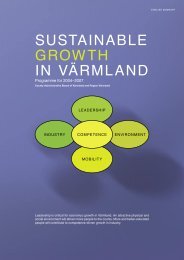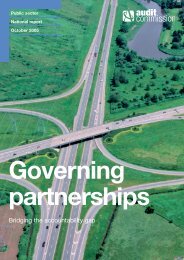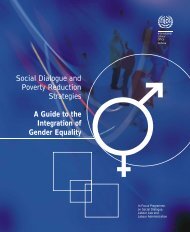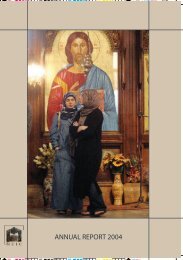PDF (222 KB) - Document Database website
PDF (222 KB) - Document Database website
PDF (222 KB) - Document Database website
Create successful ePaper yourself
Turn your PDF publications into a flip-book with our unique Google optimized e-Paper software.
ACHIEVING THE LISBON GOALS<br />
THE CONTRIBUTION OF VOCATIONAL EDUCATION AND TRAINING IN ROMANIA<br />
<br />
<br />
The Access to Education of the<br />
Disadvantaged Groups programme<br />
(2002–04) focuses on the Roma<br />
population. The programme has been<br />
implemented in 10 counties and will be<br />
extended to another 12 to 15 counties.<br />
It is jointly financed by the European<br />
Union Phare programme and the<br />
Romanian government. The main<br />
objectives are to improve the quality of<br />
pre-school education, to encourage<br />
students to complete their basic<br />
education (prevention of early dropout)<br />
and to increase participation in distance<br />
education as a second chance for those<br />
who did not complete their compulsory<br />
education.<br />
The Education in Rural Area<br />
programme (2003–09), jointly financed<br />
by the government of Romania and the<br />
World Bank, envisages the improvement<br />
of the teaching–learning process in rural<br />
areas, the development of a partnership<br />
between the school and the community,<br />
and development of management,<br />
evaluation and policy-making capacity.<br />
Preparatory steps are currently being<br />
taken. The Romanian government is<br />
offering 1 000 scholarships to students<br />
from the rural areas.<br />
In addition, in view of the low level of<br />
participation in education of the Roma<br />
population (61.4% of the total Roma<br />
population aged 7–16 in 1998 2 ), a number<br />
of measures have been introduced,<br />
including the following.<br />
<br />
<br />
<br />
<br />
The number of subsidised study places<br />
in higher education that are reserved for<br />
Roma candidates has increased to<br />
around 400.<br />
General schools and teacher training<br />
colleges have set up classes and<br />
groups for the instruction of the future<br />
teachers and trainers who are of Roma<br />
or other ethnic origin and who will be<br />
working with Roma students.<br />
Each county school inspectorate has<br />
Roma school inspectors (of Roma origin<br />
or for Roma students).<br />
With effect from the 1998/99 academic<br />
year, the Faculty of Foreign Languages<br />
and Literatures of the University of<br />
Bucharest established a department for<br />
the study of Romani language and<br />
literature.<br />
Beginner or refresher courses in the<br />
Romani language are being developed.<br />
The target group for this course is<br />
qualified or non-qualified teaching staff<br />
who are of Roma or non-Roma ethnic<br />
origin.<br />
Syllabi, textbooks and auxiliary material<br />
for the study of the Romani language,<br />
ethnic history, and traditions are being<br />
prepared.<br />
1.3 INCREASING VET AT<br />
TERTIARY AND<br />
POST-SECONDARY LEVEL<br />
There is no formal distinction between<br />
vocational- and academic-oriented<br />
programmes in universities. At the<br />
beginning of the 1990s, Romanian higher<br />
education experienced a series of<br />
significant changes, particularly in terms of<br />
student participation, university structure<br />
and academic networks.<br />
In the first half of the decade there was a<br />
significant increase in the number of<br />
students in higher education (ISCED 5–6).<br />
As the demographic peak had been<br />
reached, the student numbers remained<br />
stable during the 1995–98 period. In recent<br />
years the numbers have been on the<br />
increase again, despite the demographic<br />
decline.<br />
The higher level of participation in higher<br />
education was also favourably influenced<br />
by the expansion of the network of higher<br />
education institutions, especially following<br />
the development of private alternatives. At<br />
present the increase in the number of<br />
institutions is strictly regulated by<br />
accreditation procedures based on quality<br />
criteria as stipulated by a specific law (Law<br />
No 88/1993).<br />
In terms of subject areas, the 1990s<br />
witnessed a decline in the emphasis on the<br />
technical and agricultural disciplines in<br />
favour of the humanities, economics and<br />
law. Similarly, economics, law, philology<br />
and theology prevailed in the educational<br />
provision of private institutions.<br />
2 Indicatori privind comunitãţile de romi în România [Indicators on Roma Communities in Romania], Expert<br />
Publishing House, Bucharest, 2002.<br />
8








